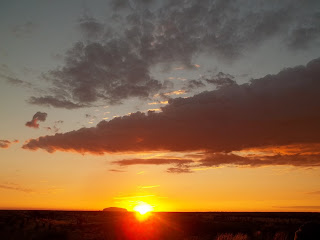Upon my arrival my host brought me straight to the office and I jumped right into things. The first week was a little slow because most of the staff were taking part in training sessions. Most of the workers are Indigenous and I was excited to learn a lot from them. But how ignorant I was! Did I think they were just going to answer every single question I asked? Wrong. Aboriginal people tend to be very shy when first meeting someone. As they got used to me being there they became more talkative and shared stories with me. They were really interested about the tour I took as well. One woman I became pretty close with. One day she led a money management course about credit that I was able to sit in on. There were five Aboriginal men taking the course and after completing it they receive a certificate. Another day at the office I helped out with the emergency relief program. People can come into the office and ask for food, clothing, and other types of vouchers. The criteria needed to receive a voucher is fairly extensive. A person can only receive three vouchers in six months. The man I helped was able to receive his second food voucher in two months worth $20. The main problems among Aboriginal people are poverty and alcoholism. Once the addiction to alcohol sets in there's very little chance of breaking it. Indigenous children have grown up among it's devastating effects for years and there's a vicious cycle that is hardly being addressed. If most of the income is spent on alcohol there is very little left over food and other necessities. If Lutheran Community Care and other organizations alike can educate people and work to put a stop to the cycle life in Alice Springs could be a lot more enjoyable for many people.
Halfway through my stay in Alice Springs I went on a tour to mix things up a bit. It was awesome! The hiking was amazing along with the history of three major landmarks - Uluru (Ayer's Rock), Kata Tjuta (the Olgas, Valley of the Winds), and King's Canyon.
Uluru at sunset
Uluru at sunrise
Some of the stories that went along with these places were really unique. Uluru gets the most attention because of its size and the pull for many people to climb it. The Aboriginal community has asked people not to climb the rock, although many still do. It is seen as a piece of their culture that can be preserved longer without human interference. Natural erosion has been constant through time, but the wear and tear on the path to the top is almost seen as offensive. The day our tour was at Uluru the climb was closed due to strong winds. By 2020 the climb will be closed indefinitely.
Part of Kata Tjuta
Kata Tjuta was amazing and probably my favorite part of the tour. Here there is more Aboriginal history. After the ceremony of becoming a man at the age of fourteen, the boys would be sent out to spend a year living among the domes of Kata Tjuta for one year before returning to their home communities and having a front tooth knocked out whereby they were officially men. It's so difficult to describe places that hold so much history and stories. People have said there's a kind of energy about both Uluru and Kata Tjuta. I definitely felt it walking through the domes, but not so much at Uluru.
The Garden of Eden in King's Canyon
King's Canyon was also fantastic. The main significance of the canyon is that it was a common route on the way to Uluru for many Aboriginals. The Garden of Eden is most important because it was one of the few sources of water on the trek to Uluru. From King's Canyon it's about 25 kilometers (15.5 miles).
So much of the Aboriginal culture is still present, yet their old ways of living are more and more being forgotten. They're currently making the transition to white Australian culture and it seems more trouble than it's worth. My time spent learning about Aboriginals has inspired me to learn more about Native Americans. I realized when someone asked me what it was like for them, I really couldn't give a solid and accurate answer. I've formed some unforgettable memories after spending time in the Northern Territory. Time passed quickly and before I knew it I was on my way back to Adelaide.






No comments:
Post a Comment